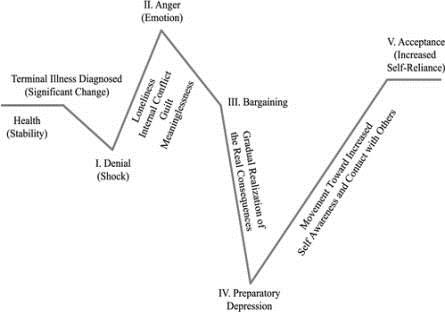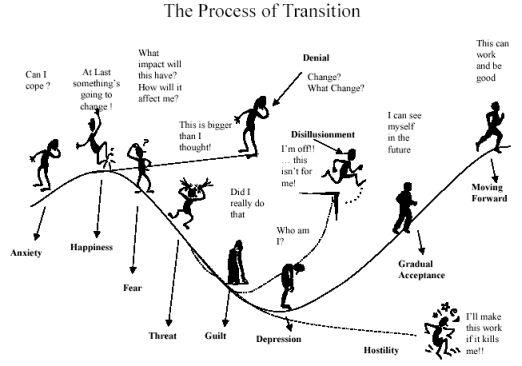Change is the only constant. Change is inevitable, ever present and experienced with ever-increasing complexity and intensity. Whether we are more aware of change within us or change as external to us is a matter of focus – what we are paying attention to.
When we accept change as a given, we are enabled to look for and find opportunities to co-create the future. In so doing, we accept some responsibility for the current situation and engage in creating small steps by which we become empowered to make choices that direct our action and bring us better and better results.
Understanding change as a process creates awareness and gives us insight into the kinds of stressors that are common to the experience of change, preparing us to face the change with more peace, strength and resolve.
Kübler-Ross Change Model
Elizabeth Kübler-Ross initially mapped stages that individuals with a terminal illness pass through, first published in her book “On Death and Dying.” Later, she applied the change model to people facing significant personal life events featuring loss or change – loss of a job, death of a loved one, divorce etc.

Kübler-Ross’ change model provides a roadmap that helps us situate ourselves somewhere within the process. Once we become aware of where we are in the process of change, we can explore and accept the feelings associated with the particular stage of change we find ourselves in, realizing, perhaps, that “This too shall pass” – that we are participating in a process that has a beginning, middle, end and then a another beginning – a new status quo.
Understanding the feelings provoked in a change process in relation to how we feel when we are performing at our best – when we are in “FLOW” can help us gain insight into the kind of actions we may want to take to further our interests.
Family therapist, Virginia Satir’s change model on the right below identifies a Foreign Element and Insight or Transformative Element as catalysts affecting momentum and the direction of the change process. When compared, the two change models present parallels. While Kübler-Ross’ model maps the emotional response to change, Satir’s model maps the change process itself.
Kübler-Ross’ designation of the vertical axis as Self-Esteem against Satir’s Capability or Performance suggests an interesting co-relation.

Our attitudes, associations from past events, underlying beliefs and assumptions are the filter that shape our perceptions.
How you experience a situation revolves around two primary dimensions – How you feel about:
- Yourself (your past, present and future)
- The situation you happen to be in
Self talk (what we say to ourselves, the stories we tell ourselves) reinforces old patterns of thought and affects how we feel about ourselves (self esteem), affecting our mental outlook, behaviour and performance. This self-talk can be managed. Coaching that is customized to your needs can help you create the right attitudes, clarify your intention and develop mental focus to help you navigate the situation successfully.

Effective change management enlists coaching and mentoring support to facilitate exploration, discovery and experimentation that generates insight, realizations, capitalizes on creative opportunities, promotes adaptation, enhances practice and cost-effective knowledge integration to arrive at an empowered new status quo.
Coaching Facilitates Change
A professional coach, equipped with change-management tools, insight and methodology gives you objective, honest feedback and helps you focus on what matters, helps you remove your blinders and challenge assumptions to design and implement strategic step by step action and bridge whatever gap you may be facing.
In the process, you may recognize that the dynamic between the Transformative Element and Foreign Element is controlled by your awareness. The flash of Insight is a moment of realization enabling you to shift perspective and recognize the “gift in the situation.”
Awareness is the greatest agent of change. It is fostered through cultivating a non-judgmental attitude. Mindful, appreciative observation without judgment enables open perception and facilitates discernment. The quality of the coaching relationship plays an important role in this process, helping the coachee see clearly to discern real threats from manufactured fears (False Evidence Appearing Real).
To Embrace Change is to Embrace Yourself
Change is inevitable and constant! By becoming intentional about accepting and even embracing change, we become pro-active and learn to make choices that inspire us and empower action. Coming to clarity frees up energy that was formerly tied up in fear, worry and anxiety. Once freed, you can redirect this energy into productive activities and respond to the situation with positive self-regard.
It’s what we, at the Kaizen Leadership Institute, help you do. Learn more about our 12 Steps to Becoming an Authentic, Mindful Leader
Knowledge is information that changes something or somebody – either by becoming grounds for actions, or by making an individual (or an institution) capable of different of more effective action. Peter Drucker





